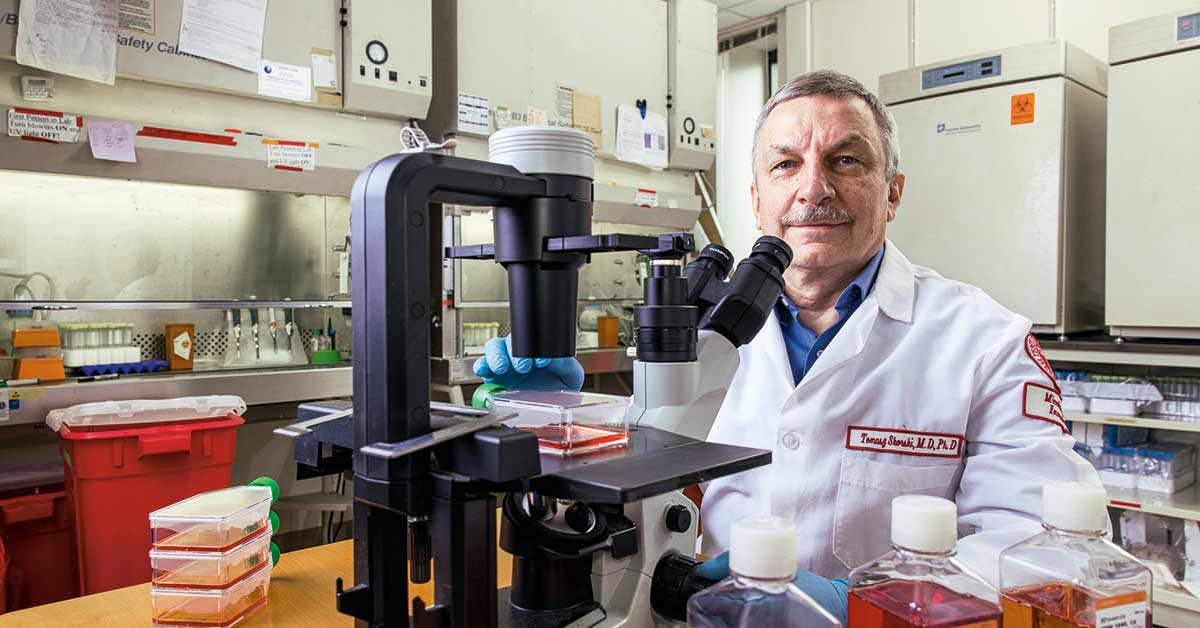
PHILADELPHIA (July 24, 2023) — Previous research has shown that blocking the ability of leukemia cells to repair self-inflicted genetic damage can cause them to die off on their own. But while this approach is effective in the short term, the cancer eventually comes back.
Now a new study by scientists at the Fels Cancer Institute for Personalized Medicine at the Lewis Katz School of Medicine at Temple University and Fox Chase Cancer Center has shown that leukemia cells can be killed much more effectively by identifying leukemias with specific genetic mutations and using a combination of DNA repair inhibitors to attack them.
The finding brings researchers a step closer to developing new treatment options for acute myeloid leukemia, one of the deadliest and treatment-resistant forms of the disease, said senior author Tomasz Skorski, MD, PhD, DSc, director of the Fels Institute and a professor in the Nuclear Dynamic and Cancer research program at Fox Chase.
“Right now, most patients diagnosed with acute myeloid leukemia will unfortunately relapse and eventually succumb to the disease,” Skorski said. “We are trying to design a completely novel treatment strategy for these patients.”
And because this new approach hinges on exploiting the DNA damage that leukemia cells inflict upon themselves, rather than attacking the cells with toxic chemotherapies, it has the potential to cause significantly fewer side effects than the current standard of care.
The new research is based on an earlier discovery that the unusual metabolism of leukemia cells fuels their rapid growth but also causes them to release toxic byproducts, including chemicals like formaldehyde and reactive oxygen species. These chemicals inflict significant genetic damage on the DNA of the cells, but the leukemia cells are able to quickly repair that damage, enabling them to keep growing.
Previous studies by Skorski’s lab showed that targeting and blocking a DNA repair pathway with an inhibitor of the enzyme called PARP1 caused leukemia cells to simply die off as a result of accumulation of their own self-inflicted DNA damage. But these results were short-lived, as the cells then used a backup mechanism for repair.
“Some of the leukemia cells could be rescued from the attack by the PARP1 inhibitor by using the alternative DNA repair pathway,” Skorski said. “So instead of targeting one pathway, you have to target PARP1 and the alternate pathway at the same time.”
For the new study, researchers identified this second pathway, which depends on an enzyme called DNA polymerase theta. Then they tested a tandem approach that combined the PARP1 inhibitor with an additional inhibitor of DNA polymerase theta, which blocked both pathways simultaneously. In both cell-based and animal studies, they found that this approach significantly enhanced the ability to kill leukemia cells.
In addition, the team found that this strategy was effective specifically in a type of leukemia that lacks the functional BRCA1 and/or BRCA2 proteins, homologous recombination-deficient leukemia. This indicates that the strategy could be part of a personalized medicine approach, with testing used to identify which patients could benefit from this combinatorial DNA repair inhibitor therapy.
Significantly, Skorski noted that both drugs used in the study are already being tested in clinical trials for solid tumors. This means there are potentially fewer barriers to repurposing them for use as a combination therapy for leukemia.
“We know that leukemia cells come already loaded with spontaneous DNA damage. By shutting down the critical repair pathways, the leukemia cells will die — all of them.” The research team’s next step is to move forward with a clinical trial to test the combined therapy, Skorski added.
The paper, “Simultaneous Targeting of DNA Polymerase Theta and PARP1 or RAD52 Triggers Dual Synthetic Lethality in Homologous Recombination-Deficient Leukemia Cells,” was published in Molecular Cancer Research.